Overview of Solid Backfilling Technology Based on Coal-Waste Underground Separation in China
Abstract
:1. Introduction
2. Research Progress of Solid Backfilling Mining Technology
2.1. Development of Solid Backfilling Mining Technology
2.2. Backfilling Mining under Buildings, Water Bodies and Railways
2.2.1. Solid Backfilling Mining under Buildings
2.2.2. Solid Backfilling Mining under Water Bodies
2.2.3. Solid Backfilling Mining Under Railways
2.3. Underground Coal-Waste Separation and Solid Backfilling Situations
2.4. The Significance of Underground Coal-Waste Separation
3. Main Underground Coal-Waste Separation Methods and Equipment
3.1. Coal-Waste Selective Crushing Methods
3.2. Dense Medium Shallow Groove Methods
3.3. Vibro-Assisted Jigging Methods
3.4. Full-Size Water Separation Methods
3.5. Ray Identification Method
3.6. Application of Underground Coal-Waste Separation
4. Underground Coal-Waste Separation and Backfilling Mining System Design
4.1. Selection of Coal-Gangue Separation Methods
4.2. Large-Section Separation Chamber Design Methods
4.3. Separation and Backfilling System Design
5. Mining-Separating-Backfilling + X
5.1. The Concept of Mining-Separating-Backfilling + X Technology
5.2. The Composition of Mining-Separating-Backfilling + X Technology
5.3. Advantages of Mining-Separating-Backfilling + X Technology
6. The Engineering Application and a Typical Case of Mining-Separating-Backfilling + X Technology
6.1. The Engineering Application Situations
6.2. A Typical Application Case in No.12 Mine of Pingdingshan Group
6.2.1. The Engineering Background
6.2.2. The Arrangement of Mining-Separating-Backfilling System
6.2.3. Key Separating Equipment
6.2.4. The Application Effects
7. Strata Control Theory in Backfilling Mining
8. Conclusions
Author Contributions
Funding
Acknowledgments
Conflicts of Interest
References
- Li, M.S. Ecological restoration of mineland with particular reference to the metalliferous mine wasteland in China: A review of research and practice. Sci. Total Environ. 2006, 357, 38–53. [Google Scholar] [CrossRef]
- Li, M.; Zhang, J.; Huang, Y.; Zhou, N. Effects of particle size of crushed gangue backfill materials on surface subsidence and its application under buildings. Environ. Earth Sci. 2017, 76, 603. [Google Scholar] [CrossRef]
- Zhao, T.B.; Ma, S.Q.; Zhang, Z.Y. Ground Control Monitoring in Backfilled Strip Mining under the Metropolitan District: Case Study. Int. J. Geomech. 2018, 18, 14. [Google Scholar] [CrossRef]
- Peng, B.; Li, X.; Zhao, W.; Yang, L. Study on the release characteristics of chlorine in coal gangue under leaching conditions of different pH values. Fuel 2018, 217, 427–433. [Google Scholar] [CrossRef]
- Gong, P.; Ma, Z.G.; Ni, X.Y.; Zhang, R.R. Floor Heave Mechanism of Gob-Side Entry Retaining with Fully-Mechanized Backfilling Mining. Energies 2017, 10, 2085. [Google Scholar] [CrossRef]
- Hasan, A.; Karrech, A.; Chareyre, B. Evaluating Force Distributions within Virtual Uncemented Mine Backfill Using Discrete Element Method. Int. J. Geomech. 2017, 17, 12. [Google Scholar] [CrossRef]
- Rukavishnikov, G.D.; Neverov, S.A.; Neverov, A.A. Substantiation of artificial composite-structure roof construction in top-down cut-and-fill stoping. In Geodynamics and Stress State of the Earth’s Interior; Kurlenya, M., Ed.; Iop Publishing Ltd.: Bristol, UK, 2018; Volume 134. [Google Scholar]
- Senapati, P.K.; Mishra, B.K. Design considerations for hydraulic backfilling with coal combustion products (ccps) at high solids concentrations. Powder Technol. 2012, 229, 119–125. [Google Scholar]
- Zhang, J.X.; Deng, X.J.; Zhao, X.; Ju, F.; Li, B.Y. Effective control and performance measurement of solid waste backfill in coal mining. Int. J. Min. Reclam. Environ. 2017, 31, 91–104. [Google Scholar] [CrossRef]
- Sun, Y.Z.; Fan, J.S.; Qin, P.; Niu, H.Y. Pollution extents of organic substances from a coal gangue dump of Jiulong Coal Mine, China. Environ. Geochem. Health 2009, 31, 81–89. [Google Scholar] [CrossRef]
- Zhang, H.; Ouyang, S. Release characteristics of heavy metals from coal gangue under simulation leaching conditions. Energy Explor. Exploit. 2014, 32, 413–422. [Google Scholar] [CrossRef]
- Li, N.; Han, B.Q. Chinese research into utilisation of coal waste in ceramics, refractories and cements. Adv. Appl. Ceram. 2006, 105, 64–68. [Google Scholar] [CrossRef]
- Liu, H.B.; Liu, Z.L. Recycling utilization patterns of coal mining waste in China. Resour. Conserv. Recycl. 2010, 54, 1331–1340. [Google Scholar]
- Xu, G.L.; Sun, C.M.; Sun, Y.; Liao, H. A New Comprehensive Utilization Method for Coal Gangue: Preparing Alite-Sulphoaluminate Cement. Adv. Mater. Res. 2013, 652, 1527–1532. [Google Scholar] [CrossRef]
- Yu, L.J.; Feng, Y.L.; Yan, W. The Current Situation of Comprehensive Utilization of Coal Gangue in China. Adv. Mater. Res. 2012, 524-527, 915–918. [Google Scholar] [CrossRef]
- Qian, M.G.; Miao, X.X.; Jia-Lin, X.U. Resources and Environment Harmonics (Green) Mining and Its Technological System. J. Min. Saf. Eng. 2006, 23, 1–5. [Google Scholar]
- Liu, J.-G.; Zhao, Q.-B. Comprehensive mechanized filling coal mining. J. China Coal Soc. 2010, 35, 1413–1418. [Google Scholar]
- Yan, H.; Zhang, J.X.; Zhou, N.; Zhang, S.; Dong, X.J. Shaft failure characteristics and the control effects of backfill body compression ratio at ultra-contiguous coal seams mining. Environ. Earth Sci. 2018, 77, 12. [Google Scholar] [CrossRef]
- Yan, H.; Zhang, J.; Wang, J.; Zhou, N.; Zhang, S. Multi-fractal characteristics of particle size distribution of granular backfilling materials under different loads. Mater. Test. 2018, 60, 202–208. [Google Scholar] [CrossRef]
- Li, J.; Huang, Y.; Qiao, M.; Chen, Z.; Song, T.; Kong, G.; Gao, H.; Guo, L. Effects of Water Soaked Height on the Deformation and Crushing Characteristics of Loose Gangue Backfill Material in Solid Backfill Coal Mining. Processes 2018, 6, 64. [Google Scholar] [CrossRef]
- Huang, P.; Spearing, A.J.S.; Feng, J.; Jessu, K.V.; Guo, S. Effects of solid backfilling on overburden strata movement in shallow depth longwall coal mines in West China. J. Geophys. Eng. 2018, 15, 2194–2208. [Google Scholar] [CrossRef]
- Guo, Q.B.; Guo, G.L.; Lv, X.; Zhang, W.X.; Lin, Y.K.; Qin, S.Y. Strata movement and surface subsidence prediction model of dense solid backfilling mining. Environ. Earth Sci. 2016, 75, 11. [Google Scholar] [CrossRef]
- Guo, G.L.; Feng, W.K.; Zha, J.F.; Liu, Y.X.; Wang, Q. Subsidence control and farmland conservation by solid backfilling mining technology. Trans. Nonferrous Met. Soc. China 2011, 21, S665–S669. [Google Scholar] [CrossRef]
- Zhang, J.; Zhang, Q.; Ju, F.; Zhou, N.; Li, M.; Zhang, W. Practice and technique of green mining with integration of mining, dressing, backfilling and X in coal resources. J. China Coal Soc. 2019, 44, 64–73. [Google Scholar]
- Teng, Y.H.; Wang, J.Z. China’s study on coal mining beneath surface buildings—State-of-the-art and developing trend. Trans. Nonferrous Met. Soc. China 2005, 15, 5–8. [Google Scholar]
- Pu, H.; Zhang, J. Research on protecting the safety of buildings by using backfill mining with solid. Procedia Environmental Sciences. 2012, 12, 191–198. [Google Scholar]
- Zhu, X.; Guo, G.; Zha, J.; Chen, T.; Fang, Q.; Yang, X. Surface dynamic subsidence prediction model of solid backfill mining. Environ. Earth Sci. 2016, 75, 1–9. [Google Scholar] [CrossRef]
- Li, H.Z.; Zha, J.F.; Guo, G.L.; Zhao, B.C.; Wang, B. Compression Ratio Design and Research on Lower Coal Seams in Solid Backfilling Mining Under Urban Areas. Soil Mech. Found. Eng. 2016, 53, 1–7. [Google Scholar]
- Zhang, J.; Shen, B. Coal mining under aquifers in China: A case study. Int. J. Rock Mech. Min. Sci. 2004, 41, 629–639. [Google Scholar] [CrossRef]
- Miao, X.; Cui, X.; Wang, J.A.; Xu, J. The height of fractured water-conducting zone in undermined rock strata. Eng. Geol. 2011, 120, 32–39. [Google Scholar] [CrossRef]
- Zhang, J.; Jiang, H.; Deng, X.; Ju, F. Prediction of the Height of the Water-Conducting Zone Above the Mined Panel in Solid Backfill Mining. Mine Water Environ. 2014, 33, 317–326. [Google Scholar] [CrossRef]
- Li, M.; Zhang, J.-X.; Deng, X.-J.; Zhou, N.; Zhang, Q. Method of water protection based on solid backfill mining under water bearing strata and its application. J. China Coal Soc. 2017, 42, 127–133. [Google Scholar]
- Yu, W.J.; Feng, T.; Chen, X.Y. Law of Ground Subsidence and Strata Movement Caused by Backfill Mining of “under Three” Coal. Adv. Mater. Res. 2013, 807, 2304–2308. [Google Scholar] [CrossRef]
- Zhang, J.; Zhang, Q.; Sun, Q.; Gao, R.; Germain, D.; Abro, S. Surface subsidence control theory and application to backfill coal mining technology. Environ. Earth Sci. 2015, 74, 1–10. [Google Scholar] [CrossRef]
- Zheng, K.H.; Du, C.L.; Li, J.P.; Qiu, B.J. Coal and Gangue Underground Pneumatic Separation Effect Evaluation Influenced by Different Airflow Directions. Adv. Mater. Sci. Eng. 2016, 2016, 6465983. [Google Scholar] [CrossRef]
- Yang, D.L.; Li, J.P.; Zheng, K.H.; Du, C.L.; Liu, S.Y. Impact-Crush Separation Characteristics of Coal and Gangue. Int. J. Coal Prep. Util. 2018, 38, 127–134. [Google Scholar] [CrossRef]
- Zheng, K.; Du, C.; Li, J.; Qiu, B.; Yang, D. Underground pneumatic separation of coal and gangue with large size (≥ 50 mm) in green mining based on the machine vision system. Powder Technol. 2015, 278, 223–233. [Google Scholar] [CrossRef]
- Honaker, R.Q.; Singh, N.; Govindarajan, B. Application of dense-medium in an enhanced gravity separator for fine coal cleaning. Miner. Eng. 2000, 13, 415–427. [Google Scholar] [CrossRef]
- Chen, J.; Chu, K.W.; Zou, R.P.; Yu, A.B.; Vince, A.; Barnett, G.D.; Barnett, P.J. How to optimize design and operation of dense medium cyclones in coal preparation. Miner. Eng. 2014, 62, 55–65. [Google Scholar] [CrossRef]
- Peng, L.; Wang, Z.; Ma, W.; Chen, X.; Zhao, Y.; Liu, C. Dynamic influence of screening coals on a vibrating screen. Fuel 2018, 216, 484–493. [Google Scholar] [CrossRef]
- Fowler, R.T.; Lim, S.C. The influence of various factors upon the effectiveness of separation of a finely divided solid by a vibrating screen. Chem. Eng. Sci. 1959, 10, 163–170. [Google Scholar] [CrossRef]
- Wang, W.; Zhang, C. Separating coal and gangue using three-dimensional laser scanning. Int. J. Miner. Process. 2017, 169, 79–84. [Google Scholar] [CrossRef]
- Miao, X.X.; Ju, F.; Huang, Y.L.; Guo, G.L. New development and prospect of backfilling mining theory and technology. J. China Univ. Min. Technol. 2015, 44, 391–399. [Google Scholar]
- Zhang, J. Study on Strata Movement Controlling by Raw Waste Backfilling with Fully-Mechanized Coal Winning Technology and Its Engineering Applications; China University of Mining & Technology: Xuzhou, China, 2008. [Google Scholar]
- Huang, Y. Ground Control Theory and Application of Solid Dense in Coal Mines; China University of Mining & Technology: Xuzhou, China, 2012. [Google Scholar]
- Zhang, Q. Roof Control Mechanism by Coordination with Backfilled Body and Backfill Support in Solid Backfill Mining Technology; China University of mining & Technology: Xuzhou, China, 2015. [Google Scholar]
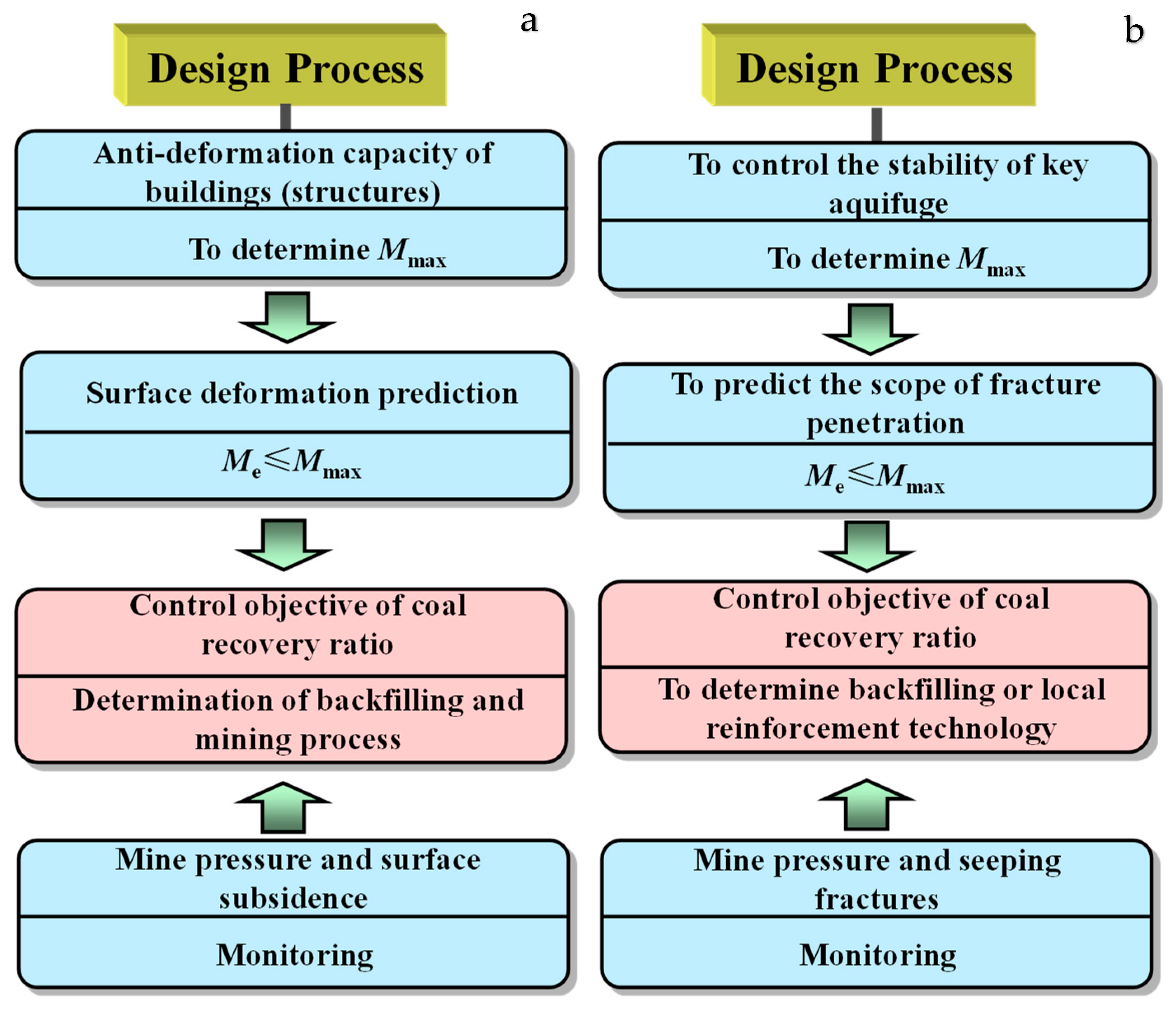
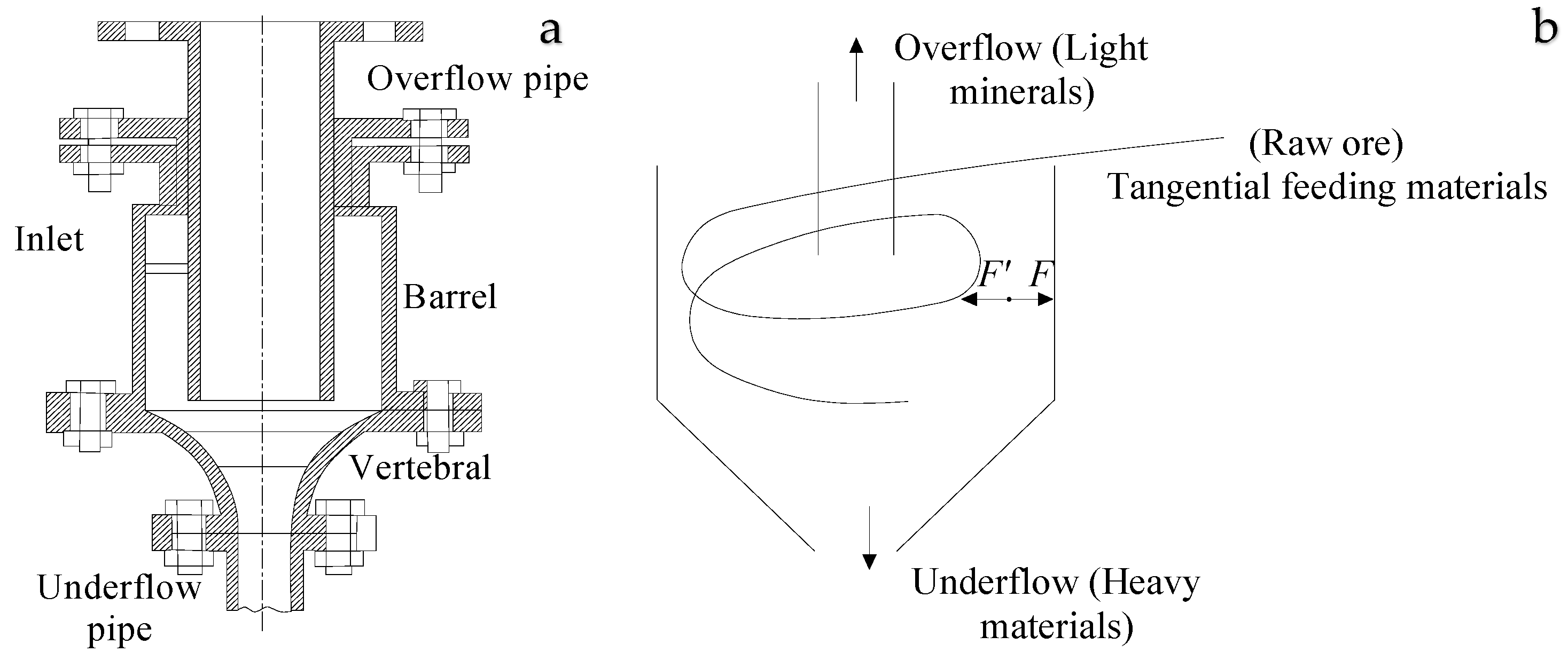
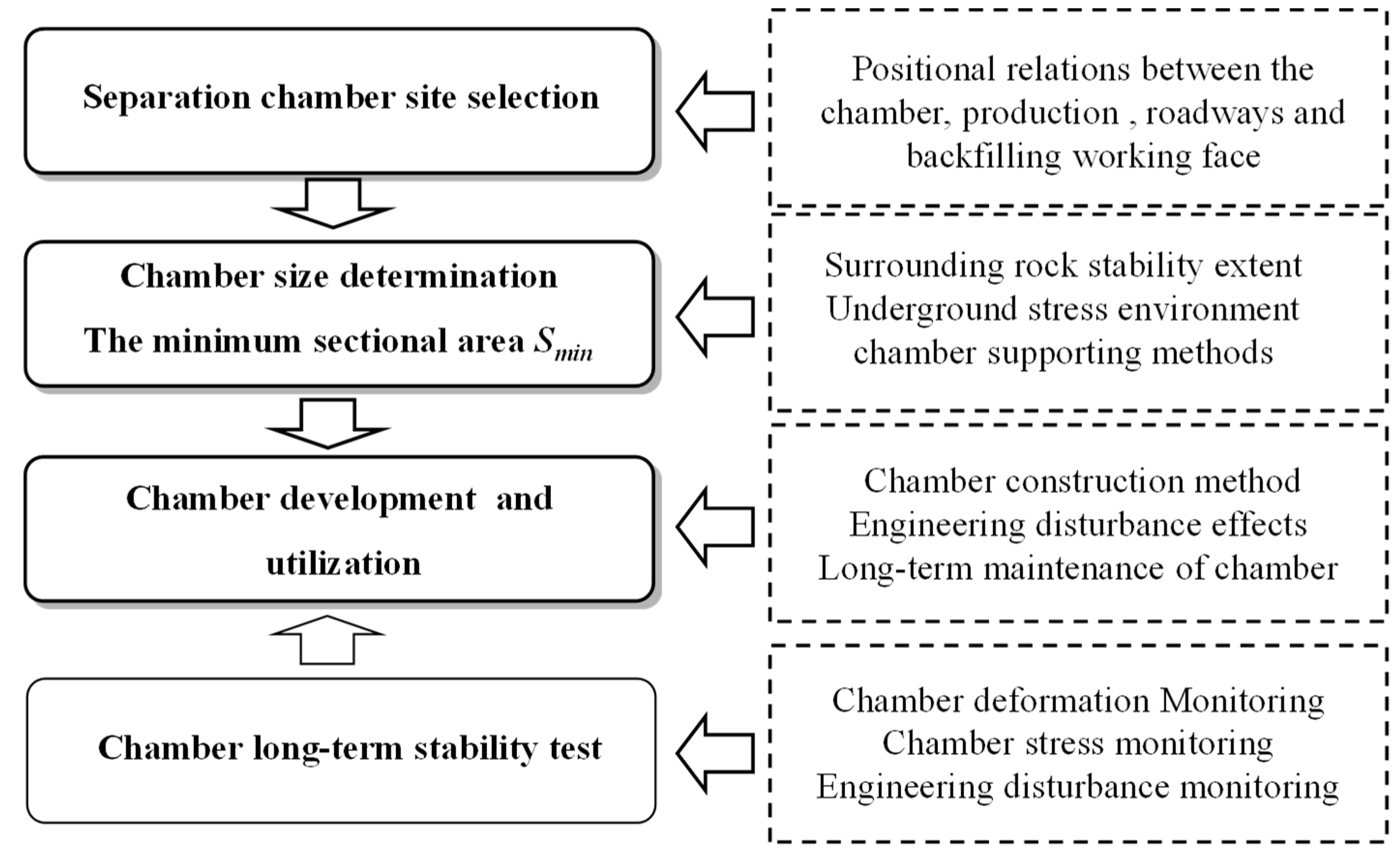
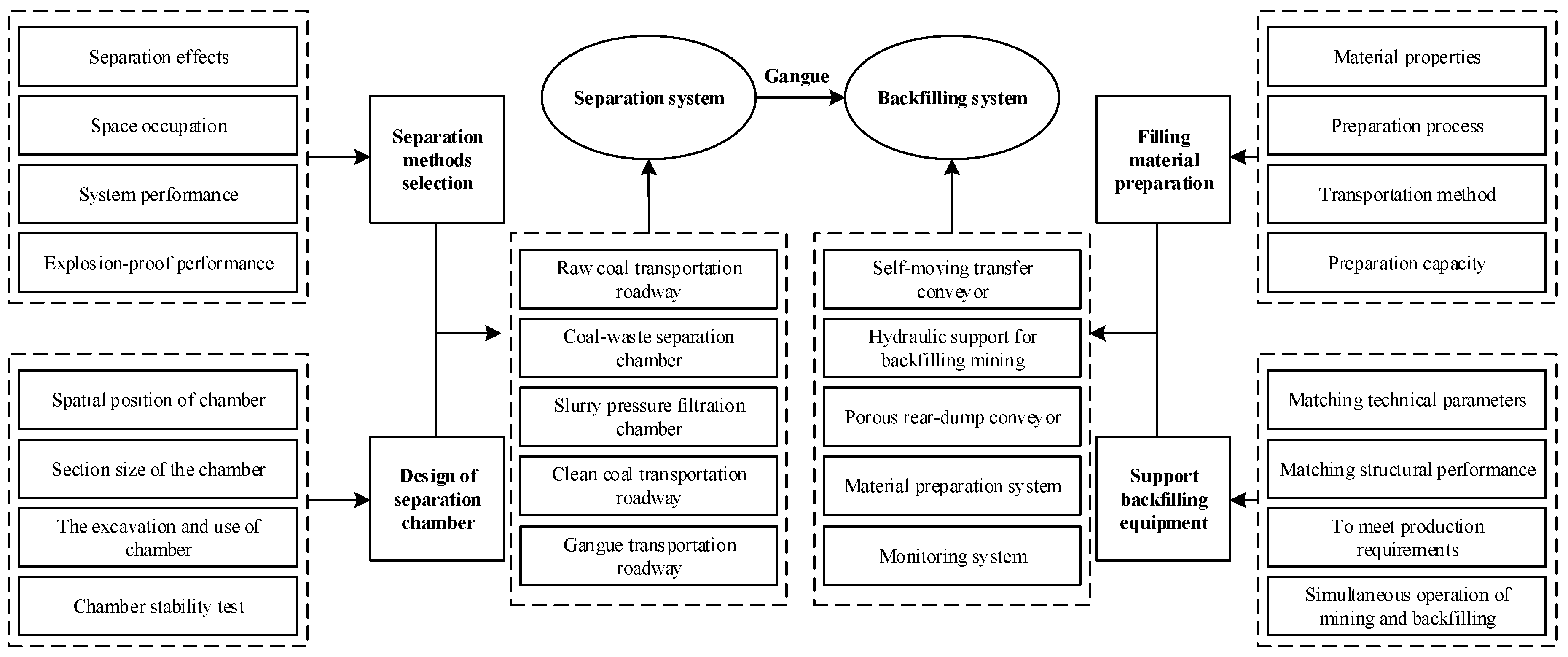
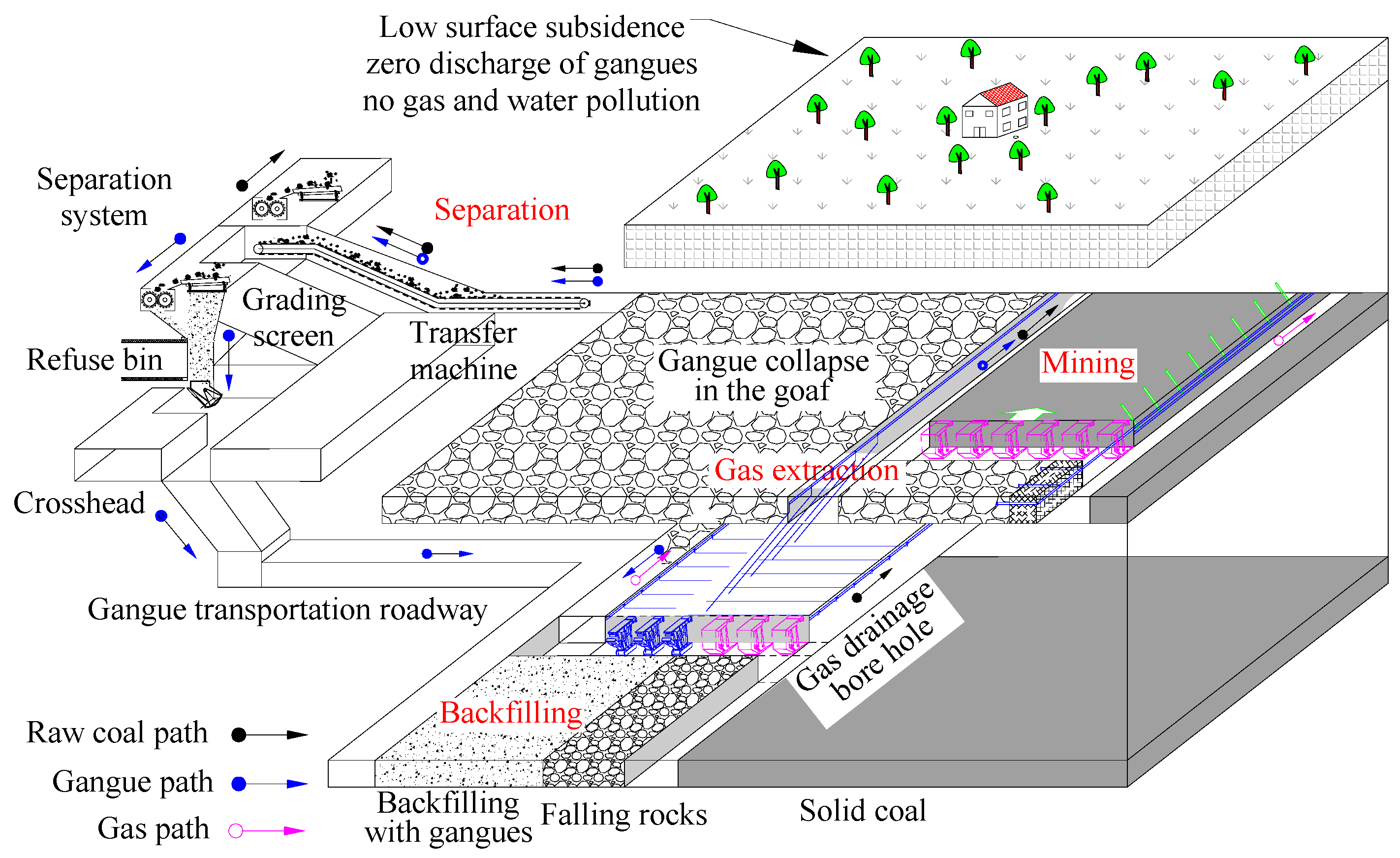

| Country | Accumulative Gangue Discharge/100 Million t | Annual Gangue Discharge/100 Million t | Main Harm | Countermeasures |
|---|---|---|---|---|
| China | 55 | 7.95 | Pollute land Trigger geological disasters | used for roads paving, power generation, building materials making, goaf backfilling |
| India | 28 | 1.07 | Pollute land | used for goaf backfilling, chemical products manufacturing |
| America | 30 | 1.05 | Waste land Produce hazardous gas | used for chemical products making |
| France | 10 | 0.85 | Waste land Pollute nvironment | used for building materials making, roads paving |
| Australia | 8.5 | 0.72 | Waste land | used for building materials making, roads paving |
| Russia | 8 | 0.61 | Produce hazardous gas Pollute land and water | used for producing cements and organic mineral fertilizers, ecological and harmless heat treatment |
| Coal Mine | Accumulative Gangue Discharge/Million t | Annual Gangue Discharge/Ten thousand t | Main Harm | Countermeasures |
|---|---|---|---|---|
| Ningdong Minefield | 26.25 | 190 | pollute environment waste land resources | Used for building materials, backfill the goaf |
| Xingtai Minefield | 23 | 250 | occupy land, pollute air, water and soil | Used for backfilling the goaf, generating power |
| Kailuan Minefield | 36 | 500 | Spontaneous combustion | Used for recovering iron sulfide and coal from gangues, backfilling pits |
| Huainan Minefield | 30 | 200 | pollute environment, occupy lands | Used for building materials; Used to backfill subsidence area |
| Datong Minefield | 200 | 2000 | pollute environment, spontaneous combustion | Used for power generation, building materials, subsidence area backfilling |
| Pingdingshan Minefield | 40 | 800 | pollute environment, occupy land | Used for ecological reconstruction, backfilling the subsidence area |
| S/N | Coal Mine | Province | Backfilling Type | Application Year |
|---|---|---|---|---|
| 1 | Zhaizhen coal mine | Shandong province | Under buildings | 2010 |
| 2 | Yangzhuang coal mine | Anhui Province | Under buildings | 2012 |
| 3 | Taiyuan coal mine | Inner Mongolia | Under buildings | 2013 |
| 4 | Xingtai coal mine | Hebei province | Under water-bodies | 2009 |
| 5 | Jisan coal mine | Shandong province | Under water-bodies | 2011 |
| 6 | Wugou coal mine | Anhui province | Under water-bodies | 2013 |
| 7 | Tangshan coal mine | Hebei province | Under railways | 2012 |
| S/N | Mine Name | Underground Separation Reasons | Separation Methods | Key Separation Equipment | Effects |
|---|---|---|---|---|---|
| 1 | Yixin Mine of Longmei Group | To relieve the pressure of main transportation system | gravity separation | Jigger, separator, crusher | Separation of 200 t/d |
| 2 | Zhaizhen Mine of Xinwen Group | To avoid raise waste rock and improve coal quality | dense medium shallow groove | XZQ1620 dense medium shallow groove machine, crusher, magnetic separator | Waste backfilling, enhanced coal quality |
| 3 | Xiezhuang Mine of XInwen Group | Many production link, high refuse rate | vibro-assisted jigging | WD4 type moving sieve jig | The lifting reduction of 180,000 t/y |
| 4 | Xishan Duerping Coal Mine | Mass waste | hydraulic coal-waste separation | Screen machine, vibrating machine, flinger | The realization of coal-waste separation underground |
| 5 | Jiyang Mine of Xinwen Group | Land occupation by waste, environmental pollution | dense medium shallow groove | dense medium shallow groove machine, crusher, sculping screen, magnetic separator | The cost reduction of 15.74 million yuan each year |
| 6 | Xingdong Mine of Jizhong Energy Group | Waste dumping on the surface | flexible air chamber jig | flexible air chamber jig, screening machine | The throughput of 60-120 t/h underground |
| 7 | Shandong Liangzhuang Mining Industry | Parting in thin coal seam | impact-type rotary | Screening and crushing machine, belt conveyor, grading sieve, separator | The gangue recovery of 70% |
| 8 | Tangshan Mine of Kailuan Group | Land occupation by waste, environmental pollution | vibro-assisted jigging | grading sieve, movable sieve jig | Separation of 800,000 t/y |
| 9 | No.12 Mine of Pingdingshan Group | Subsidiary transportation in km deep mine | dense medium shallow groove | dense medium shallow groove machine, crusher, gangue medium draining screen | The gangue throughput of 250 t/h underground |
| 10 | Xinjulong Coal Mine | Land occupation by waste, environmental pollution, lifting difficulty of transportation in deep mine | dense medium shallow groove | roll screen, lump crusher, dense medium shallow groove machine | The separation of 350~500t/h, the reduction of transportation and coal preparation burden |
| 11 | Xinyang Mine of Fenxi Mining Group | Mass waste during excavating and mining process, difficult transportation | vibro-assisted jigging | GDT23/4.6 large movable sieve jig | The separation amount of 148,700 t/y |
| Method | Space | Separation Effects | System Performance | |||||
|---|---|---|---|---|---|---|---|---|
| Size of Particles (mm) | Accuracy | Loss of Coal | Capacity | Environment | Arrangement | Costs | ||
| Selective crushing method | Relatively large occupation | 100–0 | Poor accuracy and separation effects | Suitable for pre-exhaust of coarse coal, instead of manual separation | large | large noise | relatively simple | low |
| Dense medium shallow groove method | Small occupation | 200–13 | Relatively high accuracy and good effects for coal difficult to be separated | Higher loss of coal in gangues, no high-density waste exhaust | large | purification and cyclic utilization of media | complex system, desliming before feed cleaning | relatively high |
| Vibro-assisted jigging method | Relatively large occupation | 300–25 | Poor accuracy and separation effects | Suitable for pre-exhaust of coarse coal, instead of manual separation | relatively large | purification and cyclic utilization of media | relatively simple | low |
| Full-size water separation method | Small occupation, larger altitude difference | 80–0 | Relatively high accuracy and good effects for coal difficult to be separated | Gangues exhaust with non-pressure three-product cyclone | relatively large | purification and use of coal slurry | complex system, more equipment, complex underground spatial relationships | high |
| S/N | Mine Name | Types of Chambers | Chamber Dimension length × width × height (m) | Sectional Area (m2) | Grade of Section |
|---|---|---|---|---|---|
| 1 | A mine of Kailuan Group | Jigging chamber | 28 × 7.2 × 9.77 | 55.52 | Large section |
| 2 | Changcheng No.5 Mine | Washing chamber | 25 × 7 × 8 | 47.23 | Medium section |
| 3 | Tangshan Mine of Kailuan Group | Jigging chamber | 25.8 × 6.5 ×9.27 | 46.71 | Medium section |
| 4 | Shandong Xiezhuang Mine | Coal preparation chamber | 26 × 6 × 8 | 38.13 | Medium section |
| 5 | Zhaizhen Mine of Xinwen Group | Refuse storage chamber | 2 × 1.5 × 2 | 3.00 | Small section |
| S/N | Mine Name | Issues | Situations | Effects |
|---|---|---|---|---|
| 1 | Wangzhuang Coal Mine of Zibo City | High refuse rate in raw coal, great pressure of main transportation system | Mining-separating-backfilling | Separate 200 t gangues per day. |
| 2 | Zhaizhen Coal Mine of Xinwen | Gangue raising, poor quality of raw coal, surface subsidence, mining pollution | Mining-separating-backfilling + Control | Save 200,000 yuan of electricity fee and dispose 100,000 tons of waste rock every year |
| 3 | Tangshan Coal Mine | Gangue hill piling up on the ground, ‘three under’ coal resources | Mining-separating-backfilling | 700,000 tons of gangue and fly ash are disposed every year, 2.32 million tons of coal resources are liberated |
| 4 | No.12 Mine of Pingdingshan Group | ‘three under’ coal resources, difficult gas extraction and gangue raising | Mining-separating-backfilling + Gas extraction | Profits increased by 40.408 million yuan, coal washing costs reduced by 11.76 million yuan, transportation costs reduced by 5.86 million yuan annually. |
| Type | Coal Quantity/ten thousand t | Environmental Benefits | |||
|---|---|---|---|---|---|
| Mining State | Reduction of gangue discharging/ten thousand t | Reduction of gangue occupying land/hectare | Reduction of gas drainage/100 million m3 | ||
| The mining of the first mining face | 134 | 32 | 9 | 1.2 | |
© 2019 by the authors. Licensee MDPI, Basel, Switzerland. This article is an open access article distributed under the terms and conditions of the Creative Commons Attribution (CC BY) license (http://creativecommons.org/licenses/by/4.0/).
Share and Cite
Zhang, Q.; Zhang, J.; Wu, Z.; Chen, Y. Overview of Solid Backfilling Technology Based on Coal-Waste Underground Separation in China. Sustainability 2019, 11, 2118. https://doi.org/10.3390/su11072118
Zhang Q, Zhang J, Wu Z, Chen Y. Overview of Solid Backfilling Technology Based on Coal-Waste Underground Separation in China. Sustainability. 2019; 11(7):2118. https://doi.org/10.3390/su11072118
Chicago/Turabian StyleZhang, Qiang, Jixiong Zhang, Zhongya Wu, and Yang Chen. 2019. "Overview of Solid Backfilling Technology Based on Coal-Waste Underground Separation in China" Sustainability 11, no. 7: 2118. https://doi.org/10.3390/su11072118
APA StyleZhang, Q., Zhang, J., Wu, Z., & Chen, Y. (2019). Overview of Solid Backfilling Technology Based on Coal-Waste Underground Separation in China. Sustainability, 11(7), 2118. https://doi.org/10.3390/su11072118





